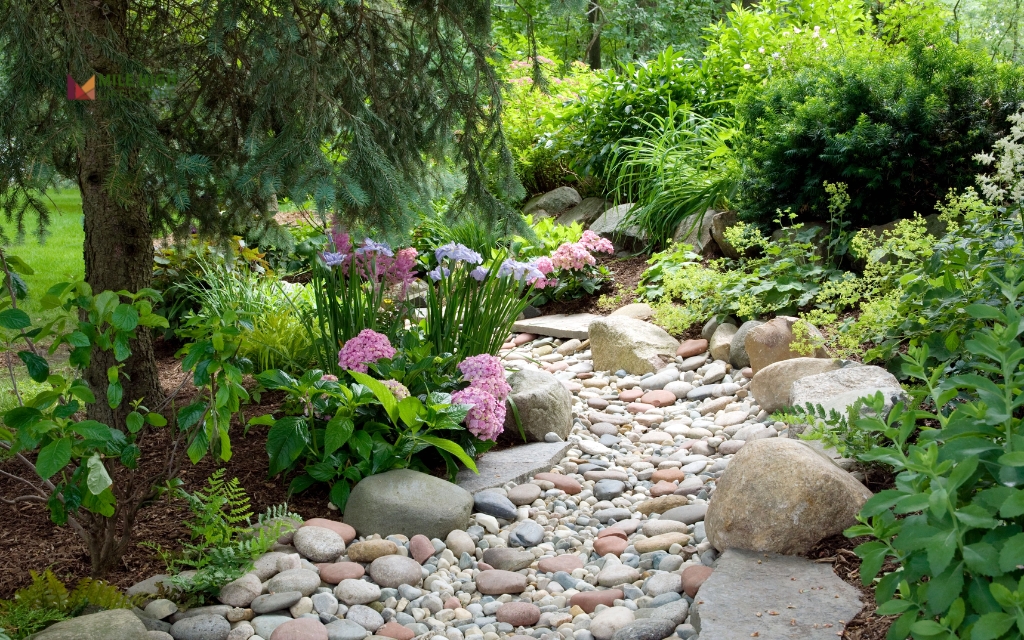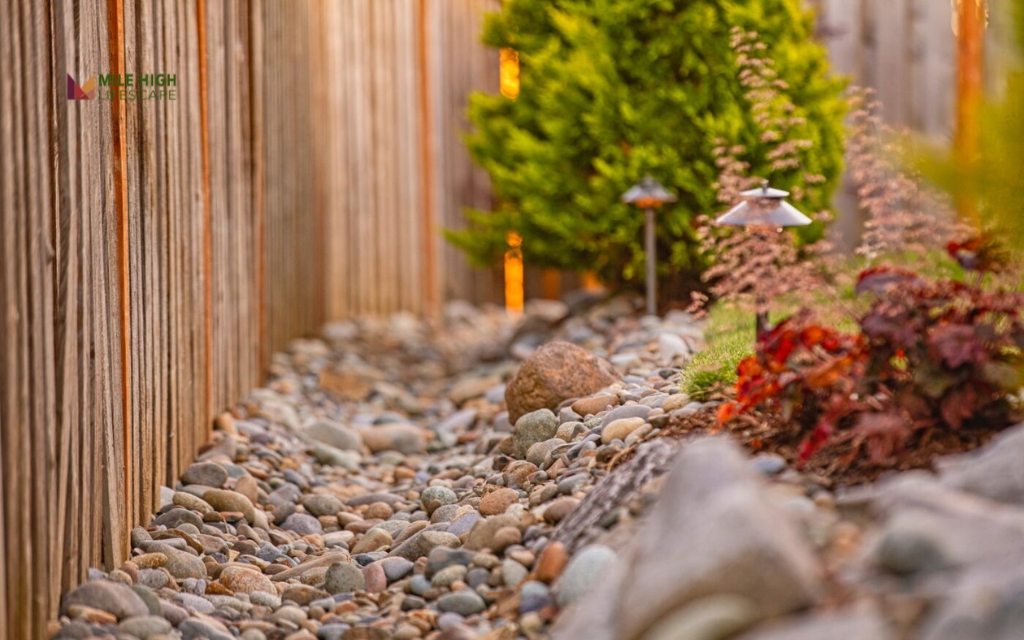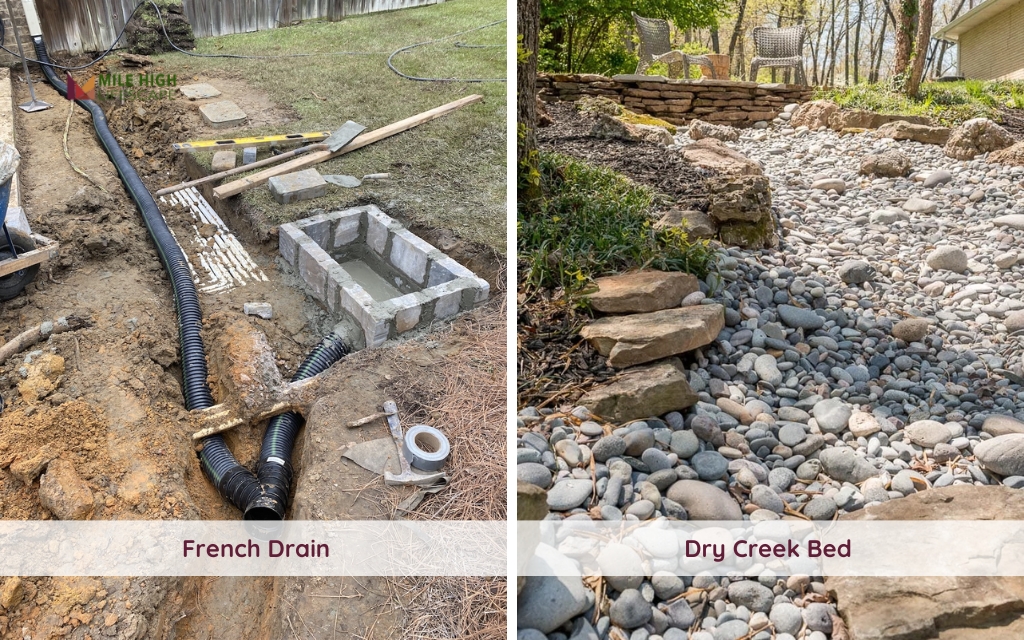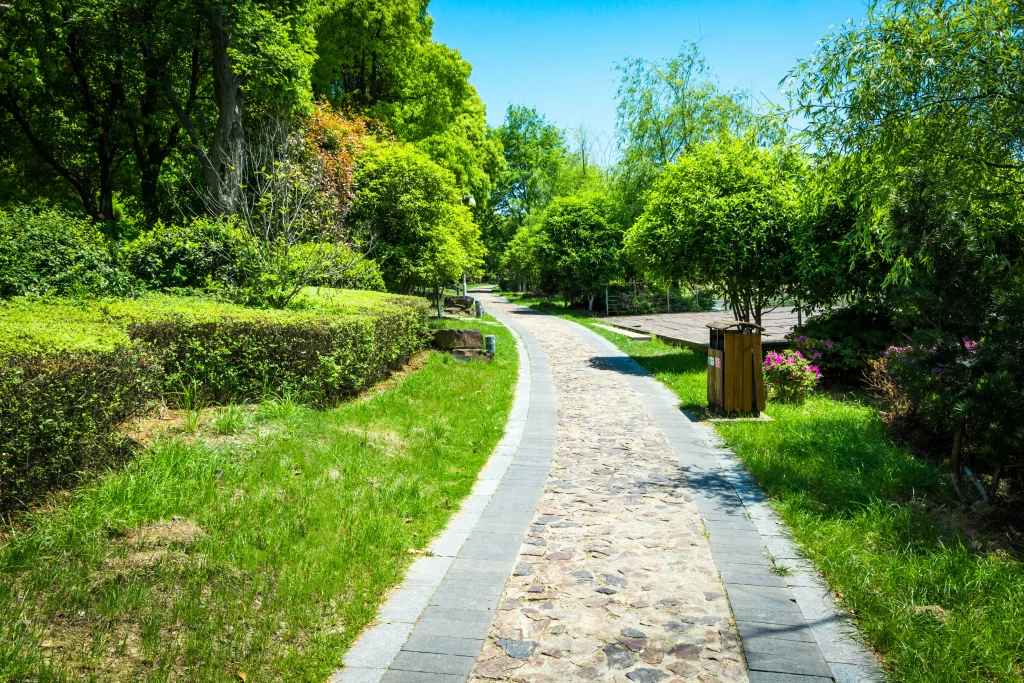Water pooling can lead to serious issues for your property in Denver, such as soil erosion, damage to your foundation, and creating habitats for pests like mosquitoes. Thankfully, there are two effective drainage solutions to address flooding: dry creek bed vs French drains.
A French drain is an underground system that gathers and channels water through a perforated pipe, keeping it from gathering in unwanted spots. In contrast, a dry creek bed resembles a natural stream, guiding water along a specific route away from your property. Both solutions are effective for drainage, so your decision will come down to your personal preference.
What is a Dry Creek Bed?
A dry creek bed is an engineered drainage channel that combines function with aesthetic appeal. Unlike traditional gutters or pipes, these carefully constructed waterways use natural materials like river rock and gravel to create a path for surface water to flow away from vulnerable areas of your property.
The system works by capturing runoff from downspouts, driveways, or naturally low spots in your yard, then channeling this water along a carefully graded stone-lined path to a designated drainage area. Unlike many drainage solutions, dry creek beds remain visible year-round, transforming from flowing waterways during rain to attractive landscape features during dry periods.

Advantages:
- Creates an eye-catching landscape accent that mimics natural stream beds
- Perfectly suited for sloped terrains and existing natural drainage patterns
- Prevents soil erosion while adding visual interest to your property
- Requires minimal maintenance beyond occasional debris removal
Disadvantages:
- Limited to surface water management—cannot address underground water issues
- Occupies visible space in your landscape design
- May accumulate leaves and debris requiring periodic cleaning
What is a French Drain?
A French drain represents a completely different approach to water management. This subsurface drainage system consists of a perforated pipe surrounded by gravel or small stones, all wrapped in filter fabric and buried in a sloped trench. Rather than managing surface water, French drains target groundwater infiltration, keeping basements dry and preventing soil saturation.
The ingenious design allows water to percolate through the gravel, enter the perforated pipe, and flow away from problem areas. This underground approach protects foundations from hydrostatic pressure and eliminates soggy spots without disrupting your landscape’s appearance.

Advantages:
- Operates entirely underground, maintaining your yard’s aesthetic integrity
- Effectively combats rising water tables and prevents basement moisture
- Ideal for flat properties where surface drainage isn’t feasible
Disadvantages:
- Higher installation costs due to excavation and specialized materials
- Requires precise grading to ensure proper water flow
- Potential for clogs over time if not properly filtered
Comparing French Drains with Dry Creek Beds
Understanding the differences between these drainage systems becomes clearer when viewing their key features side by side. This comparison helps Denver homeowners match their specific drainage challenges with the most effective solution.
Feature | Dry Creek Bed | French Drain |
| Type of Drainage | Surface water management | Subsurface water control |
| Visual Appeal | High landscape integration | Hidden installation |
| Ideal Yard Condition | Sloped terrain with visible runoff | Flat areas with soil saturation |
| Maintenance | Debris clearing as needed | Periodic inspection for clogs |
| Installation Cost | $1,500–$5,000 | $3,000–$8,000 |
| DIY-Friendly? | Moderate skills required | Professional installation advised |
How to Choose the Right Drainage Solution?
- Water Type Considerations: Surface drainage problems—visible pooling, driveway runoff, or erosion—often call for dry creek beds. When dealing with saturated soil, basement seepage, or foundation threats, French drains provide the necessary subsurface management.
- Aesthetic Preferences: Consider whether you want drainage as a visible landscape element or a hidden solution. Dry creek beds add visual interest while controlling water, whereas French drains operate invisibly beneath the surface.
- Space Requirements: Dry creek beds need adequate width and length to function properly and look natural. French drains require only trenching space and won’t impact your yard’s usability.
- Budget Factors: In Denver’s market, professional dry creek bed installation typically ranges from $1,500 to $5,000, while French drain systems run $3,000 to $8,000 due to excavation requirements. These costs reflect proper grading, materials, and installation expertise.
- DIY Skill Assessment: Small dry creek beds can be DIY projects for experienced homeowners, but proper slope calculation remains crucial. French drains demand professional installation to ensure correct pipe orientation, gravel placement, and filter fabric installation.

Choosing the Right Drainage Solution Between Dry Creek Bed vs French Drain
When choosing between a dry creek bed and French drain, the “best” solution depends entirely on your specific drainage problem. For surface water management—like driveway runoff, roof downspouts, or erosion on sloped properties—a dry creek bed works best. It channels water away while adding visual appeal to your landscape.
For subsurface water issues—including soggy yards, basement moisture, rising water tables, or foundation threats—a French drain is the superior choice. It captures groundwater before it becomes a problem, operating invisibly underground.
Simply put: Use a dry creek bed for visible water that runs across your property’s surface. Choose a French drain for water that saturates your soil from below. For Denver properties with both issues, combining these systems often provides the most comprehensive solution.

Conclusion
The choice between a dry creek bed and French drain depends on your specific water management needs. Surface water issues often benefit from the aesthetic appeal of dry creek beds, while subsurface problems demand French drain solutions. Mile High Lifescape’s expertise in Colorado drainage solutions ensures your property receives the right system, expertly installed.
Contact Mile High Lifescape today at (303) 877-9091 for a comprehensive drainage evaluation. Send photos of your problem areas to hello@milehighlifescape.com for immediate consultation. Your landscape deserves professional protection from water damage—let our experience guide your drainage solution.
Frequently Asked Questions (FAQs)
Can dry creek beds and French drains work together?
Absolutely. Complex properties with both surface and groundwater issues often benefit from integrated systems. We design hybrid solutions that manage water comprehensively.
How long do these drainage systems last?
French drains typically function for 30-40 years with proper maintenance. Dry creek beds can last indefinitely, requiring only occasional stone adjustment after extreme weather events.
What’s the best time to install drainage systems?
Spring and fall offer ideal conditions when soil is workable but not frozen. This timing minimizes landscape disruption and ensures proper settling before extreme weather.
Are permits required in Denver?
Major earthmoving or connections to municipal storm systems may require permits. Mile High Lifescape handles all permitting processes, ensuring full compliance.
Can I install these systems myself?
Dry creek beds are more DIY-accessible, though proper grading remains essential. French drains require specialized knowledge of soil dynamics, pipe placement, and filter fabric installation—professional installation strongly recommended.
